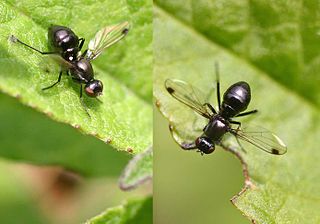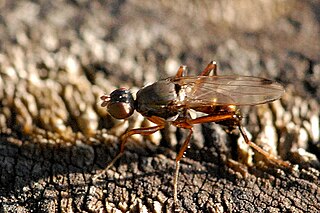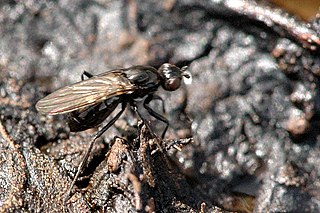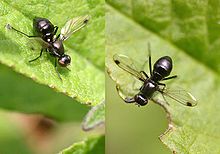
The Sepsidae are a family of flies, commonly called the black scavenger flies or ensign flies. Over 300 species are described worldwide. They are usually found around dung or decaying plant and animal material. Many species resemble ants, having a "waist" and glossy black body. Many Sepsidae have a curious wing-waving habit made more apparent by dark patches at the wing end.

The Phoridae are a family of small, hump-backed flies resembling fruit flies. Phorid flies can often be identified by their escape habit of running rapidly across a surface rather than taking to the wing. This behaviour is a source of one of their alternate names, scuttle fly. Another vernacular name, coffin fly, refers to Conicera tibialis. About 4,000 species are known in 230 genera. The most well-known species is cosmopolitan Megaselia scalaris. At 0.4 mm in length, the world's smallest fly is the phorid Euryplatea nanaknihali.

A black fly or blackfly is any member of the family Simuliidae of the Culicomorpha infraorder. They are related to the Ceratopogonidae, Chironomidae, and Thaumaleidae. Over 2,200 species of black flies have been formally named, of which 15 are extinct. They are divided into two subfamilies: Parasimuliinae contains only one genus and four species; Simuliinae contains all the rest. Over 1,800 of the species belong to the genus Simulium.

The Fanniidae are a small group of true flies largely confined to the Holarctic and temperate Neotropical realms; there are 11 Afrotropical species, 29 Oriental, and 14 Australasian.

Empididae is a family of flies with over 3,000 described species occurring worldwide in all the biogeographic realms but the majority are found in the Holarctic. They are mainly predatory flies like most of their relatives in the Empidoidea, and exhibit a wide range of forms but are generally small to medium-sized, non-metallic and rather bristly.

Phormia regina, the black blow fly, belongs to the blow fly family Calliphoridae and was first described by Johann Wilhelm Meigen.

Sepsis cynipsea is a European species of fly and member of the family Sepsidae. It is a coprophagous fly that feeds on dung. These flies are most commonly found around freshly laid cattle dung where they eat and reproduce. Due to human agricultural practices involving cows, these flies are now common in other areas of the world.

Sepsis is a genus of flies in the family Sepsidae.
Sepsis biflexuosa is a Cosmopolitan species of fly and member of the family Sepsidae.

Sepsis violacea is a European species of flies and member of the family Sepsidae.

Sepsis punctum is a European species of flies and member of the family Sepsidae.

Themira putris is a European species of fly and member of the family Sepsidae.
Sepsis flavimana is a European species of flies and member of the family Sepsidae.
Sepsis nigripes is a European species of flies and member of the family Sepsidae.

Themira leachi is a European species of fly and member of the family Sepsidae.
Orygma luctuosum is a European species of fly and member of the family Sepsidae.
Diptera is an order of winged insects commonly known as flies. Diptera, which are one of the most successful groups of organisms on Earth, are very diverse biologically. None are truly marine but they occupy virtually every terrestrial niche. Many have co-evolved in association with plants and animals. The Diptera are a very significant group in the decomposition and degeneration of plant and animal matter, are instrumental in the breakdown and release of nutrients back into the soil, and whose larvae supplement the diet of higher agrarian organisms. They are also an important component in food chains.
Sepsis thoracica, more commonly known as the black scavenger fly, a species of fly from the genus Sepsis and the family Sepsidae. It was discovered by Robineau-Desvoidy in 1830. It resembles a small flying ant. The fly is most commonly found inhabiting cow dung.
Orygma is a European genus of fly from the family Sepsidae.











